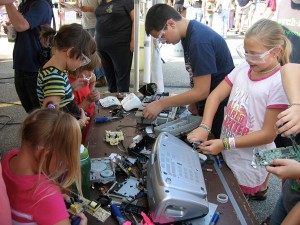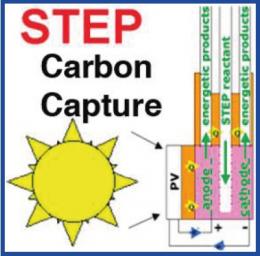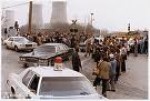Ingenuity: From Inside Out…
Posted on August 26, 2010
Filed Under Technology | Leave a Comment
Here’s a Web source for getting technological inspiration going – Make magazine, tagline: “Technology on Your Time.”
We happened upon the site’s feature on how kids learn by taking things apart, and there was instant recognition of what some kids we know have been up to. Also, why TechRepublic’s “teardown” feature is so popular.
 We seem to have an innate fascination for seeing how things fit together, or go together. “Sidewalk superintendents” at construction projects are another example of this proclivity.
We seem to have an innate fascination for seeing how things fit together, or go together. “Sidewalk superintendents” at construction projects are another example of this proclivity.
Not that we’re suggesting that taking things apart that really shouldn’t be taken apart is a good idea (unless you’re adept at putting them back together), but it can be a source of inspiration. And, if the target object – like those at Make’s Robotics Redefined both at Detroit’s recent Maker Faire is dispensable anyway, you have a way to keep kids occupied for hours, while revving up their ingenuity circuits.
They took an old turntable, for instance, and turned it into a geared, rotating candle holder. “What would you do with that?” you ask. That’s not the point. But the answer might well be, “Maybe something.”
There’s been a fair amount of attention lately to America’s innovation standing (is it threatened?), including in Bloomberg Businessweek. Find enough mechanisms for kids to take apart and recombine into something new, however, and we’re likely to be reassured.
Anyhow, Make magazine seems worth following. We might be inspired by its own “insides.” And that, of course, is the editors’ intention. – Doug Bedell
San Jose Heads Into a Green Future, Really
Posted on August 12, 2010
Filed Under Technology | Leave a Comment
We last wrote about acting decisively either to debunk or apply new technologties, not just announce them and see them seemingly ignored.
 Now here’s a city that’s acting decisively in, you might expect it, the Silicon Valley. San Jose, CA, in 2007 announced its “Green Vision” – a 15-year plan that includes reducing per capita energy use by half, becoming a zero waste city, recycling and reusing 100 percent of the city’s water, and moving to 100 percent renewable energy. Right on!
Now here’s a city that’s acting decisively in, you might expect it, the Silicon Valley. San Jose, CA, in 2007 announced its “Green Vision” – a 15-year plan that includes reducing per capita energy use by half, becoming a zero waste city, recycling and reusing 100 percent of the city’s water, and moving to 100 percent renewable energy. Right on!
San Jose’s resolves are especially pertinent because we’ve also been writing about the progress toward launching electric cars. A detriment has been the lack of charging stations along highways and byways. But San Jose is doing someting about that.
The California city recently installed the first of 1,600 planned charging stations in the Bay Area as part of the ChargePoint America program to encourage the use of electric cars – by those who can currently afford the Chevy Volt, the Nissan Leaf or the Ford Focus EV, anyway.
San Jose is aiming to break the chicken-or-egg dilemma over which comes first toward reaching a green future. Encouraged by San Jose’s resolve, Couloumb Technologies, the maker of that city’s first charging station, is expecting to have 4,600 of them around the country by October, 2011, in areas including Austin, Detroit, Los Angeles, New York, Washington, D.C. and Orlando.
San Jose’s first charging station is inside a parking garage, appropriately enough – except, of course, that you’d first have to pay a parking fee to reach it. But who can quibble over a city as resolutely aiming for a greener future as San Jose appears to be?
TechRepublic is the source of the highly informative, amply illustrated web story that’s prompting these acclamations for San Jose and electric car makers. And we ought to give some further credit where credit is due on the road to the future. Couloumb’s $37 million Charge Point America program is funded in part by $15 million from the U.S. Department of Energy under the American Recovery and Reinvestment Act.
Lest we get too enthused about the appearance of these first charging stations, TechRepublic points out that the big deterrent to the adoption of electric cars (other than price) is the need for “bigger, better battery technology.” We’ll try to follow that too, for it appears that we’re actually heading toward a less gasoline-reliant future. – Doug Bedell
Could We Breathe As If There Were No Factories?
Posted on August 4, 2010
Filed Under Technology | Leave a Comment
We keep hearing about how various solar power approaches are key to our energy and environmental future, yet none seem to be applied all that decisively. Here’s a newly announced approach that should either be debunked or applied resolutely.
 Researchers who have developed the STEP (Solar Thermal Electrochemical Photo) process say it could decrease carbon dioxide in the atmosphere to pre-industrial levels in 10 years. That is, we could have the atmosphere we had before factories, automobiles and trucks started appearing on earth.
Researchers who have developed the STEP (Solar Thermal Electrochemical Photo) process say it could decrease carbon dioxide in the atmosphere to pre-industrial levels in 10 years. That is, we could have the atmosphere we had before factories, automobiles and trucks started appearing on earth.
Why wouldn’t that be considered a goal worthy of priority sponsorship, providing it’s truly feasible? In one continuing STEP activity, we could put the debate over a healthy atmosphere aside; science could triumph.
What is it about announcements that seem so promising, and then aren’t heard about again, at least on a scale sufficient to make a real difference?
In this case, scientists at George Washington University and Howard University, both in Washington DC, and strategic, even, to government, say that “by using the sun’s visible light and heat to power an electrolysis cell that captures and converts carbon dioxide from the air, a new technique could impressively clean the atmosphere and produce fuel feedstock at the same time.”
The new process is described in a paper just published in The Journal of Physical Chemistry Letters. “The significance of the study is twofold,” Stuart Licht, a chemistry professor at George Washington University, told PhysOrg.com. “Carbon dioxide, a non-reactive and normally difficult-to-remove compound, can be easily captured with solar energy using our new low-energy, lithium carbonate electrolysis STEP process, and with scale-up, sufficient resources exist for STEP to decrease carbon dioxide levels in the atmosphere to pre-industrial levels within 10 years.”
So if this is indeed feasible, why don’t we get on with it? Or is our society in a continuing cycle of discussion and debate that keeps promising approaches to environmental goals from being applied not only successfully, but decisively? One would hope not. – Doug Bedell
(Image copyright: Stuart Licht, et al. ©2010 American Chemical Society)
Memory’s a Dance, Says Dr. Day
Posted on July 30, 2010
Filed Under Business, Technology, The Writing Life | Leave a Comment
Permit us to introduce you to Ruth S. Day, a cognitive scientist at Duke University. Why? Because Dr. Day is doing intensive study of memory, and memory is large where everything begins, in technical writing as well as other fields, not to mention life itself.
 Dr. Day has been studying how professional dancers remember their routines. Have you ever thought about that? A modern dance company doesn’t have classical terms for movements, like ballet companies do. So some, like Pilobolus, make up names for the shapes they get their dancer’s bodies into – like “shooting seagulls” or “fat gnomes.” Others, like The Merce Cunningham company, feel that labeling dance moves with words is limiting.
Dr. Day has been studying how professional dancers remember their routines. Have you ever thought about that? A modern dance company doesn’t have classical terms for movements, like ballet companies do. So some, like Pilobolus, make up names for the shapes they get their dancer’s bodies into – like “shooting seagulls” or “fat gnomes.” Others, like The Merce Cunningham company, feel that labeling dance moves with words is limiting.
Memory itself is sort of a dance of associations. Pick your own associations.
“There’s no right or wrong strategy,” Day says, “but certain strategies work better in certain situations and the more memory tools a dancer has, the better. The end goal is not memory in and of itself, but to get past the learning and worrying about it – to do the movement well and enjoy it.”
It all seems to come down to identification and intentionality – identifying what you want to accomplish via a technique or gimmick – anything that works for you – and being intentional about that process.
We’re trying, for instance, to improve our quick recognition of jazz piano passages. And we’re finding that looking at the notes as parts of chords is helpful – that’s a structural approach, rather than a strictly visual one. But what the heck, since it seems to have potential, we’ll try to develop it.
“Whatever works for you,” seems to be a decent memory slogan. The need is to get serious about remembering, and pick your own cues.
Dr. Day has more insights into this subject – What subject was that ? Oh yes, memory – at physorg.com and some further encouragement. We’re glad we’ve met her via the web, and suspect you will be as well. – Doug Bedell
On Garages as Inspiring Places…
Posted on July 24, 2010
Filed Under Business, Technology | Leave a Comment
 We had occasion to note the entrepreneurial importance of garages as start-up locales in our last Insights post on Andy Grove’s concerns about the status of U.S. manufacturing. One such garage – where Bill Hewlett and Dave Packard got started 70 years ago was designated a national historic landmark in 2007.
We had occasion to note the entrepreneurial importance of garages as start-up locales in our last Insights post on Andy Grove’s concerns about the status of U.S. manufacturing. One such garage – where Bill Hewlett and Dave Packard got started 70 years ago was designated a national historic landmark in 2007.
As we happened upon that bit of Internet information, we wondered about the garage where Steve Jobs and Steve Wozniak developed the first Apple computer almost 35 years ago.  We haven’t been readily able to determine its present status, but that garage was part of Jobs’ parents’ home on Crist Drive in Los Altos, CA. (The two Steves actually began creating their revolutionary computer in a spare bedroom, then moved production to the garage.)
We haven’t been readily able to determine its present status, but that garage was part of Jobs’ parents’ home on Crist Drive in Los Altos, CA. (The two Steves actually began creating their revolutionary computer in a spare bedroom, then moved production to the garage.)
Both these garages, of course, are part of the high-tech Silicon Valley story and we normally don’t cover computer technology, because lots of other blogs do. But garages initially aren’t mystical places. They’re handy, available, low-budget spaces with a roof and probably electricity. They only become famous when the ingenuity employed in them proves to be truly visionary.
Even so, we thought you’d enjoy seeing two of the nation’s most famous garages. If your kids want a place to indulge some of their ideas, make yours available. It may become a laboratory setting, a convenient outlet for creativity and, with luck, a source of great wealth. – DB
Doing Anything Creative Today?
Posted on July 14, 2010
Filed Under Business, Technology | Leave a Comment
Newsweek has done the U.S. a service by devoting its July 19 cover to “Creativity in America,” a lengthy article sparked by the discovery that creativity in America is declining. By whose measure comes that ominous news?
 Well, there are IQ tests and there’s a creativity test – the Torrance test (named after the late Prof. E. Paul Torrance), which has been around for 50 years. While IQ scores have been steadily rising, since 1990 Torrance scores have been steadily declining.
Well, there are IQ tests and there’s a creativity test – the Torrance test (named after the late Prof. E. Paul Torrance), which has been around for 50 years. While IQ scores have been steadily rising, since 1990 Torrance scores have been steadily declining.
Newsweek reports that Kyung Hee Kim at the College of William & Mary discovered the creativity decline just this May in analyzing almost 300,000 Torrance scores of children and adults. “It’s very clear, and the decrease is very significant,” Kim says, adding that the decline is “most serious” among younger children, from kindergarten through sixth grade.
As Newsweek notes, such a decline could have dire consequences as the kids age. The situation should cause each of us to think about how creatively we’ve been living, and what we might do to boost our flashes of insight and brilliance.
This can be truly serious. Factors from excessive TV watching to neglecting to encourage creativity in schools are cited. “In China,” by contrast, advises Newsweek, “there has been widespread education reform to extinguish the drill-and-kill teaching style. Instead, Chinese schools are also adopting a problem-based learning approach.”
Jonathan Plucker, of Indiana University, was amazed in touring schools in Shanghai and Beijing to find a boy “who, for a class project, rigged a tracking device from his moped with parts from a cell phone.”
When the faculty of a Chinese university asked Plucker to identify trends in American educatiion, “he described our focus on standardized curriculum, rote memorization, and nationalized testing. ‘After my answer was translated, they just started laughing out loud,’ Plucker says. ”They said, ‘You’re racing toward our old model. But we’re racing toward your (fancied) model, as fast as we can.”
“Your model,” to the extent it exists in American schools currently, is a project- and research-oriented one that can be included in existing curriculums if educators and school boards recognize that it needs to be. We all need to get serious about improving our creativity, now and for the long term.
We can start by simply logging how many good ideas we’ve had recently, and encouraging more of them to dawn by reading and looking around at what needs to be accomplished in the interest of ourselves and others. Thanks Newsweek! – Doug Bedell
Scientists, Engineers Need to Relate Well
Posted on July 12, 2010
Filed Under Technology | Leave a Comment
Why do we neglect what’s common among us as a people, like the best ways of being understood? These thoughts arise on reading a news release by the American Academy of Arts and Sciences on the evident communication gap between science and technology and the rest of the public.
 The Academy is apparently trying to nudge scientists and engineers to relate better, if they want to be understood, maybe even supported, by the rest of the us.
The Academy is apparently trying to nudge scientists and engineers to relate better, if they want to be understood, maybe even supported, by the rest of the us.
Why, otherwise, would scientists need to be reminded that “Scientific issues require an ‘anticipatory approach'”?
The Adademy continues: “A diverse group of stakeholders – research scientists, social scientists, public engagement experts, and skilled communicators – should collaborate early to identify potential scientific controversies and the best method to address resulting public concerns.”
“Gee, you mean we need to relate to the public?” we can hear white-coated researchers asking. Sure do, this is basic public relations – the techniques have been known for decades, maybe eons. How is it that many scientists, enough for the Academy to be holding workshops and issuing pointed recommendations, have missed the message?
Apparently, not all scientists and engineers understand that their work needs to be done in the context of their times, in the midst of other people. And that respecting context requires listening to, understanding and being responsive to concerns that might arise over their work.
Yet that’s more PR 101.
We’re pleased to see the independent, non-partisan American Academy of Arts & Sciences addressing these concerns in its 230th year (it was founded during the American Revolution by John Adams, John Hancock and others). But we regret the necessity of tutoring scientists in communication roles that should be well-settled by now.
This all gives new meaning to the stricture, “We always need to keep learning,” doesn’t it? Science and engineering can be highly demanding of those of practice their disciplines, but one of those disciplines should be listening and relating to others. And that requires planning PR protocols as well as scientific ones. – Doug Bedell
Nuclear’s Preparedness Lessons
Posted on June 29, 2010
Filed Under Business, Technology | Leave a Comment
 Like all of you, I’ve been watching with increasing dismay the gulf oil fiasco. Amid the scenes of gushing crude, oil-soaked birds, and iridescent marshes it is easy to forget that good and competent people are working around the clock trying to stop the oil. At some point they will succeed and we can get on with Phase 2: Endless litigation and interminable government hearings. Will any good come from all the Sturm und Drang? If the last such accident of national consequence is any indication, perhaps the answer is yes.
Like all of you, I’ve been watching with increasing dismay the gulf oil fiasco. Amid the scenes of gushing crude, oil-soaked birds, and iridescent marshes it is easy to forget that good and competent people are working around the clock trying to stop the oil. At some point they will succeed and we can get on with Phase 2: Endless litigation and interminable government hearings. Will any good come from all the Sturm und Drang? If the last such accident of national consequence is any indication, perhaps the answer is yes.
After Three Mile Island (TMI) the U.S. nuclear power industry went through all the Kubler-Ross stages:
• Denial: This appears to be much ado about nothing.
• Anger: Dammit… who screwed up, whose fault is this?
• Bargaining: Whoa, slow down with all the proposed regulations…let’s just reason together.
• Depression: This industry is dead; there’s no way we can afford all these new rules and retrofits.
• Acceptance: We’re still America’s best energy hope; we’re going to come back stronger than ever.
 After TMI the nuclear industry did some soul-searching and decided: One more event like this and we are doomed as an industry, so let’s make sure it doesn’t happen again. And many of the innovations that followed TMI have contributed to the industry’s excellent performance and budding renaissance. These include:
After TMI the nuclear industry did some soul-searching and decided: One more event like this and we are doomed as an industry, so let’s make sure it doesn’t happen again. And many of the innovations that followed TMI have contributed to the industry’s excellent performance and budding renaissance. These include:
• Creating the Institute of Nuclear Power Operations to set benchmarks, identify and exchange power plant best practices, and generally pursue operational excellence.
• Creating the World Association of Nuclear Operators to do more or less the same thing across national borders
• Funding ambitious government research projects that investigated exactly how nuclear accidents initiate and progress, including a major initiative on the human factors component
• Conducting large-scale experiments to duplicate the TMI events and learn exactly what happened, down to very subtle chemical effects occurring inside the nuclear fuel
• Nuclear utility competitors pooling their resources to sponsor their own accident prevention research
• New accident detection and prevention technologies mandated for new plants and retrofit into existing plants
Looking at this list, I see a path – after this oil well is capped and the cleanup is behind us – towards a much safer and better run offshore oil industry. Oil will be in our future for all of our lifetimes. Let’s make sure we do it right.
And oh by the way nuclear industry, it’s been 30+ years since TMI. Are you still looking over your shoulder and remembering your 1979 lesson of eternal vigilance? – Dennis Owen
Good Management Requires Empathy Above All
Posted on June 27, 2010
Filed Under Business, Technology | Leave a Comment
Nobody said being a manager is easy. Actually, being a good manager, being relationally successful with colleagues, superiors, customers or communities, can be very demanding. Especially if some of those folks are difficult themselves, which they can be.
So how does a manager prepare himself, or steel herself, for difficult days? This is an especially pertinent question for technologists whose training has been in abstractions and demanding details, not so much in relationships.
 Steve Roesler, a management consultant, makes a notable contribution to understanding what it takes to manage well in his All Things Workplace blog. He writes of the “Five Minds of a Manager”, yes five. But if you can get these traits and techniques in hand, corporate challenges are likely to go better.
Steve Roesler, a management consultant, makes a notable contribution to understanding what it takes to manage well in his All Things Workplace blog. He writes of the “Five Minds of a Manager”, yes five. But if you can get these traits and techniques in hand, corporate challenges are likely to go better.
Steve is actually quoting principles he came upon in an article entitled, uncannily, “Five Minds of a Manager” by Johnathan Gosling and Henry Mitzberg. (What he hasn’t done is provide a link to the piece. But Supermind Google advises that it was in The Harvard Business Review of November, 2003 – wisdom, of course, doesn’t have to be current.)
The five principles, actually “mindsets,” for relating well are what matter and here they are. They are days, we can recall, when we wish we had them all on tap and tuned tight:
1. Reflective mindset
“Stepping back and reflecting on experiences allow mistakes to be identified. Reflection may also lead to seeing things in a new ways, e.g., a product as a service or customers as partners (or vice versa).”
2. Analytical mindset
“Go beyond crunching the numbers. When a decision must be made, analyze the analysis of others to determine the biases they may have had and the data and assumptions used.”
3. Wordly mindset
There are lots of worlds within the world and cultural awareness is crucial.
4. Collaborative mindset
Don’t hole up in your office – get out and mingle with your staff and customers, and listen more than direct.
5. Action mindset
“Managers with action mindsets focus organizational energy on changing what needs to be changed while carefully maintaining what doesn’t.”
Yes, these are all important vantage points. But we might suggest one overarching principle that’s indispensable for successful managing – empathy, walking in someone else’s shoes and identifying with what’s firing them up. Be sure, in other words, to relate well to those shaping your managerial world. – Doug Bedell
Photo – FreeDigialPhotos.net
Japanese Spacecraft Breaks Up Returning From a Billion-Mile Trip
Posted on June 17, 2010
Filed Under Technology | Leave a Comment
The NASA guys keep broadcasting neat things. You hardly ever know when, or who’s listening. But here’s a NASA team video of a Japanese unmanned spacecraft, the Hayabusa, reentering earth’s orbit and breaking up into flaming pieces that the NASA guys think are “beautiful.” Fascinating, yes, but “beautiful” doesn’t seem quite the word for something that’s being destroyed after a trip of 1.25 billion miles.
The video has become a viral hit on YouTube, with well over 200,000 viewers. It was made from a NASA DC-9 airborne laboratory.
The Hayabusa was launched in May, 2003, Mashable advises, to reach the Itokawa comet, “in order to gather samples from the comet and study the astral body’s characteristics, including its topography, trajectory, speed and composition. The spacecraft reached the comet in September 2005.”
When it reached the earth’s atmosphere on its return trip recently, the Hayabusa started breaking up into hundreds of flaming pieces. It was as though it was leaving a punch-tape record across the heavens, and then the tape “caught fire” and disintegrated.
This writer has to refresh himself on why it’s necessary to loose returning unmanned space vehicles like this one. But for now, it’s enough to know that the scientists only needed the canister the Hayabusa had with the samples it collected and they’ve retrieved that from its landing place in South Australia.
So have a look at what’s caused all the excitement at NASA and on YouTube. – Doug Bedell
f
« go back — keep looking »Recently
- Presentations With Forethought
- Technical Writing’s Lineage – Surely It’s Deeper than Digital
- At the Holidays, Twitting Amazon
- Successful Cookie Baking – From Mom, an Acknowledged Expert
- Slides for a Tech Writer’s Craft
- Digital or Not, Be Clear
- Being Watchful About Digital Designs…
- When Proposals Don’t Click, Keep Making Them Anyway
- Like a Good Gardener, Help an Enterprise Keep Itself Current
- We’re Leaders All, And Need to Think That Way
Categories
Archives
- January 2017
- December 2016
- November 2016
- October 2016
- September 2016
- August 2016
- July 2016
- June 2016
- May 2016
- April 2016
- March 2016
- February 2016
- January 2016
- December 2015
- November 2015
- October 2015
- September 2015
- August 2015
- July 2015
- June 2015
- May 2015
- April 2015
- March 2015
- February 2015
- January 2015
- December 2014
- November 2014
- October 2014
- March 2014
- February 2014
- January 2014
- December 2013
- November 2013
- October 2013
- September 2013
- August 2013
- July 2013
- June 2013
- May 2013
- April 2013
- March 2013
- February 2013
- January 2013
- December 2012
- November 2012
- October 2012
- September 2012
- August 2012
- July 2012
- June 2012
- May 2012
- April 2012
- March 2012
- February 2012
- January 2012
- December 2011
- November 2011
- October 2011
- September 2011
- August 2011
- July 2011
- June 2011
- May 2011
- April 2011
- March 2011
- February 2011
- January 2011
- December 2010
- November 2010
- October 2010
- September 2010
- August 2010
- July 2010
- June 2010
- May 2010
- April 2010
- March 2010
- February 2010
- January 2010